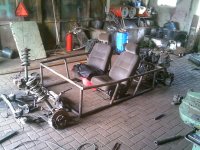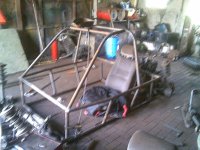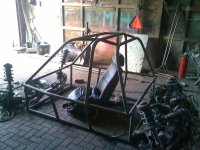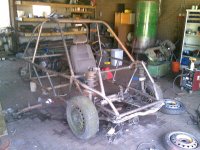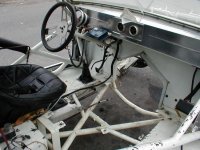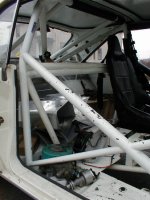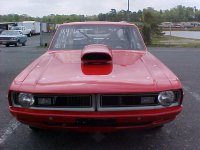Renze
Elite Member
Me and my friend have collected various car parts to build a dirt buggy:
The cars we used for our Dukes of Hazzard style jumps, usually lasted only a day, because the engine mounts ripped off from the bounces.. (the Dukes used about 3 Chargers per filming day... )
)
Because petrol is allmost unaffordable in Holland at 1.40 Euro per liter, i removed 2 front subframes of front wheel drive Volvo 440 1.9 turbo diesel. Diesel is about 1 euro per liter, and agricultural dyed diesel is about 70 cents per liter. The 1.9 intercooled turbo diesel engine puts out about 90 horses, and with some fuel and boost pressure adjustments its capable of 110 to 120 hp. Plenty of horses for a 500 kg dirt buggy.


Úsing an existing subframe means you have a complete package of wheel suspension, steering, engine and driveline mounted on a frame which can be bolted to the vehicle by 4 bolts with rubber bushings. It gives you a head start because all critical components are already aligned and all wheel mounting points are tested for durability by a few thousand cars on the road.
I saved my first 440 TD front end for parts for my second 440 TD, but when my boss took a corner too tight with the truck and semitrailer at the companies parking lot, i suddenly had 2 1.9 TD drivelines available....
I have 2 weeks of holiday, with plenty of things to do. My goal is to at least get a rolling chassis during my holiday, so i am able to quickly roll it out of the workshop when i need the workshop for other things.
I took some pictures with my Nokia, so they are a bit fuzzy but you get the idea.
photo 1:
I spent about an hour walkign around, not knowing where to start, as i normally build trailers (built around 2 hot rolled steel frame beams) instead of buggies with an open cage construction.
Then i decided to start with the parts that allowed the most design freedom, which is the passenger cage, and later add the parts to mount both Volvo subframes, so i could better visualise where all the supports for the subframe mountings and spring mounts would go.
It turned out to be a good method, because within an hour or 2, i had what can be seen in photo 1.
photo 2:
I used the hydraulic pipe bender to bend a roll bar over the spot where the seats would go. Unfortunately i had only 1 pipe die, which was for a 1" pipe, not for 1,5" so i pressed the pipe oval in the bend. To reduce the effect of making the pipe oval, i bent it in 3 or 4 places to make just 1 bend.
photo 3:
an extra hoop is added to the rollbar, and some pipes from the front part of the passenger cage to the rollbar are added.
photo 4:
I've built the mounts for the front subframe, with steering housing. I had to bend the front quite a bit to work around the springs. I also had to chamfer off the front part of the passenger cage, because the front wheels couldnt sit there because they hit the lower front tube.
When i bolted some wheels on it, it really started to appeal.
several people that came around during the holiday, asked me when they could test drive it...
At the rear, i'll be using the complete front wheel drive drivetrain at the back, just like Toyota used a Camry front wheel drive driveline in the back of the MR2 rear wheel drive sports car.
Photos will follow when i have time to continue.
The cars we used for our Dukes of Hazzard style jumps, usually lasted only a day, because the engine mounts ripped off from the bounces.. (the Dukes used about 3 Chargers per filming day...
Because petrol is allmost unaffordable in Holland at 1.40 Euro per liter, i removed 2 front subframes of front wheel drive Volvo 440 1.9 turbo diesel. Diesel is about 1 euro per liter, and agricultural dyed diesel is about 70 cents per liter. The 1.9 intercooled turbo diesel engine puts out about 90 horses, and with some fuel and boost pressure adjustments its capable of 110 to 120 hp. Plenty of horses for a 500 kg dirt buggy.
Úsing an existing subframe means you have a complete package of wheel suspension, steering, engine and driveline mounted on a frame which can be bolted to the vehicle by 4 bolts with rubber bushings. It gives you a head start because all critical components are already aligned and all wheel mounting points are tested for durability by a few thousand cars on the road.
I saved my first 440 TD front end for parts for my second 440 TD, but when my boss took a corner too tight with the truck and semitrailer at the companies parking lot, i suddenly had 2 1.9 TD drivelines available....
I have 2 weeks of holiday, with plenty of things to do. My goal is to at least get a rolling chassis during my holiday, so i am able to quickly roll it out of the workshop when i need the workshop for other things.
I took some pictures with my Nokia, so they are a bit fuzzy but you get the idea.
photo 1:
I spent about an hour walkign around, not knowing where to start, as i normally build trailers (built around 2 hot rolled steel frame beams) instead of buggies with an open cage construction.
Then i decided to start with the parts that allowed the most design freedom, which is the passenger cage, and later add the parts to mount both Volvo subframes, so i could better visualise where all the supports for the subframe mountings and spring mounts would go.
It turned out to be a good method, because within an hour or 2, i had what can be seen in photo 1.
photo 2:
I used the hydraulic pipe bender to bend a roll bar over the spot where the seats would go. Unfortunately i had only 1 pipe die, which was for a 1" pipe, not for 1,5" so i pressed the pipe oval in the bend. To reduce the effect of making the pipe oval, i bent it in 3 or 4 places to make just 1 bend.
photo 3:
an extra hoop is added to the rollbar, and some pipes from the front part of the passenger cage to the rollbar are added.
photo 4:
I've built the mounts for the front subframe, with steering housing. I had to bend the front quite a bit to work around the springs. I also had to chamfer off the front part of the passenger cage, because the front wheels couldnt sit there because they hit the lower front tube.
When i bolted some wheels on it, it really started to appeal.
several people that came around during the holiday, asked me when they could test drive it...
At the rear, i'll be using the complete front wheel drive drivetrain at the back, just like Toyota used a Camry front wheel drive driveline in the back of the MR2 rear wheel drive sports car.
Photos will follow when i have time to continue.
Attachments
Last edited:
